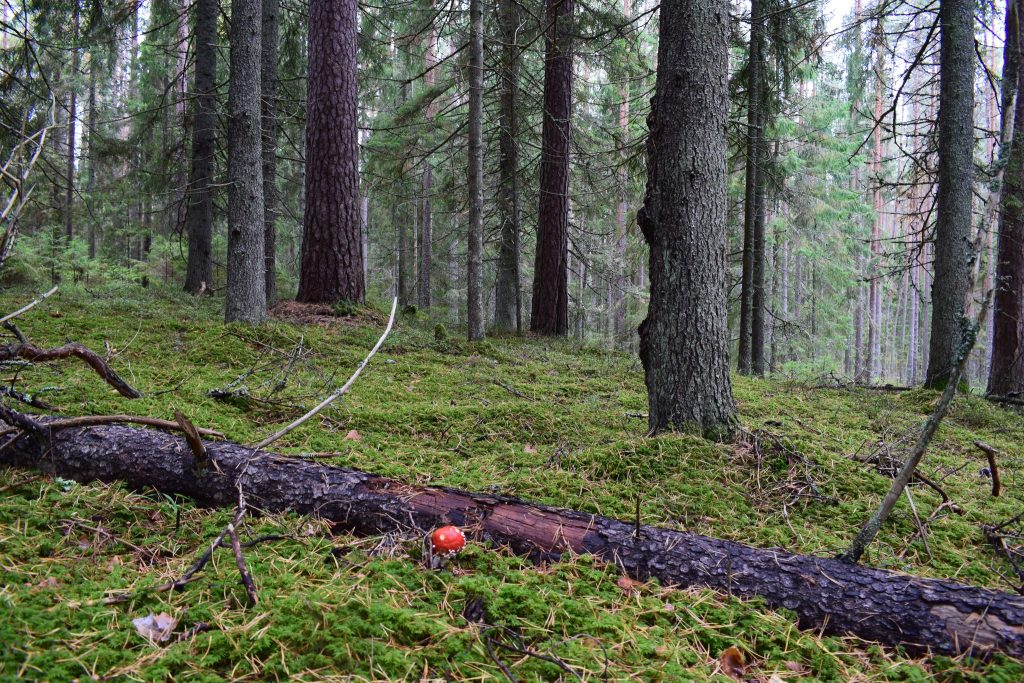Many people have their own “home” forest in Estonia. An Estonian’s sense of home isn’t complete without a home woods. Here, a notable difference arises between Estonians and many other peoples. Whereas the forest instills a sense of security among the former, Europeans tend rather to experience fear. Estonians feel uneasy when they meet another person in the forest; for Europeans, it’s the opposite: the woods are frightful when devoid of people.
Making oneself feel at home in the forest takes a good couple of decades, or sometimes an entire generation; only then does one start to understand the heart of the woods. Man is capable of making perhaps one or two forests “home” over the course of his lifetime; no more. The charm of Estonia’s landscape lies in the fact that we have hundreds of forests made “home”. This entails a number of conditions: a certain inclination to do so from birth, grandpa’s stories, grandma’s mushroom-picking basket, and a passion for the woods. Falling in love with a person and with a landscape can be surprisingly similar experiences: the feeling progresses through comparable stages. Over their lifetime, a person will fall deeply in love no more than twice. Many places, just like many people, will never become dear to a person: the initial emotion may dissipate before long, and the person sets off on their journey once again.
Someone who has made a forest home knows well what it entails. It is a place, with which the person shares their sadness, joy, and solitude; a place, for which they feel reverence, remembering the stories that have transpired there. It is a place where something unusual has happened; where people have gone since time immemorial seeking food or natural medicines; where things that strangers need not know have happened. Many such sites are also coated in a film of military history, being places where people hid themselves, fought, and died. For many, the forest is similarly a cemetery they go to with the same feeling as if visiting an ancestor’s grave. This sense of memory makes the forest a sacred place. Many families can still vividly recollect battles, raids, and relatives who were casualties. The heart of the forest remembers it all, and perhaps it is especially because of these difficult times that people associate the woods with a place where our ancestors speak to us.
The forest can never be made entirely home. Yet, someone who has finally won over the forest’s heart may nevertheless be lucky enough to encounter its secrets; to bear witness to it becoming the Great Mystery. Such a person will face treks across endless phantomlike expanses and experience, time and again, the dark and radiant pain of the land; one that gives life meaning and is embedded in the formula for human happiness, which derives from the spirit of the place.
I likewise grew up in the shadow of a dark and distant war, which adults would occasionally speak of in terse terms. Mom hid out in the woods during a wartime summer when she was a child; Grandpa was shot during a raid, and later died. I know my grandfather through a school diploma, a couple of faded pictures, and a silver cufflink engraved with the initials HU (Herbert Utt). I had to imagine Grandpa literally attached to the cufflink, and that is the image I had of him when I was little: barefoot, carrying an old hunting rifle, and wearing a gigantic cufflink.
There was a big moss-covered boulder in those very same woods. When Grandma was gathering mushrooms, she would stop at it and tell me the story of a forest fairy, which terrified me at that age. According to legend, there existed a certain shadowy spot that people used as a hiding place during the Great Northern War. Before I began to understand the forest as a part of nature, I saw it as a part of history and oral tradition. I believe that this precise moment defines Estonians’ perception of the forest, on the whole. It is an inseparable element of culture and ethno. It is, simultaneously, a place for deep thought, a cemetery, a sanctuary, and a door into another reality. The forest is like a mandatory part of a family’s heritage and history.
For many people, a home forest becomes a member of the family over time and is named, just like children or pets – a name that is passed down from generation to generation. In some sense, children, pets, and a home forest do make up the great Estonian family tree. Until just recently, there was a nice enduring custom of delivering bread or other food to a home forest for wild animals to partake in on holidays. The most common Estonian name for a home forest is Sinilillemets – Liverwort Woods; no doubt the handsome title has ties to Estonians’ very first memories of the forest. I’m also reminded of much more frightening names from the vicinity of the town of Tarvastu, such as Ghost Woods, Old Hag Hollows, Hunger Marsh, and more. Names were also given to individual trees, such as Big Birch, Birdcherry Bush, and the Rightbird Tree. The latter was an old fir that sometimes moaned darkly in the wind like an unknown bird. Toponyms are often older than the landscapes themselves: for example, my grandmother referred to our mighty century-old fir grove as the ‘bare pasture’.
All images credit – Valdur Mikita
Taken from the book Forestonia by Valdur Mikita. Translated from Estonian by Adam Cullen.
© Deep Baltic 2025. All rights reserved.
Like what Deep Baltic does? Please consider making a monthly donation – help support our writers and in-depth coverage of Estonia, Latvia and Lithuania. Find out more at our Patreon page.

